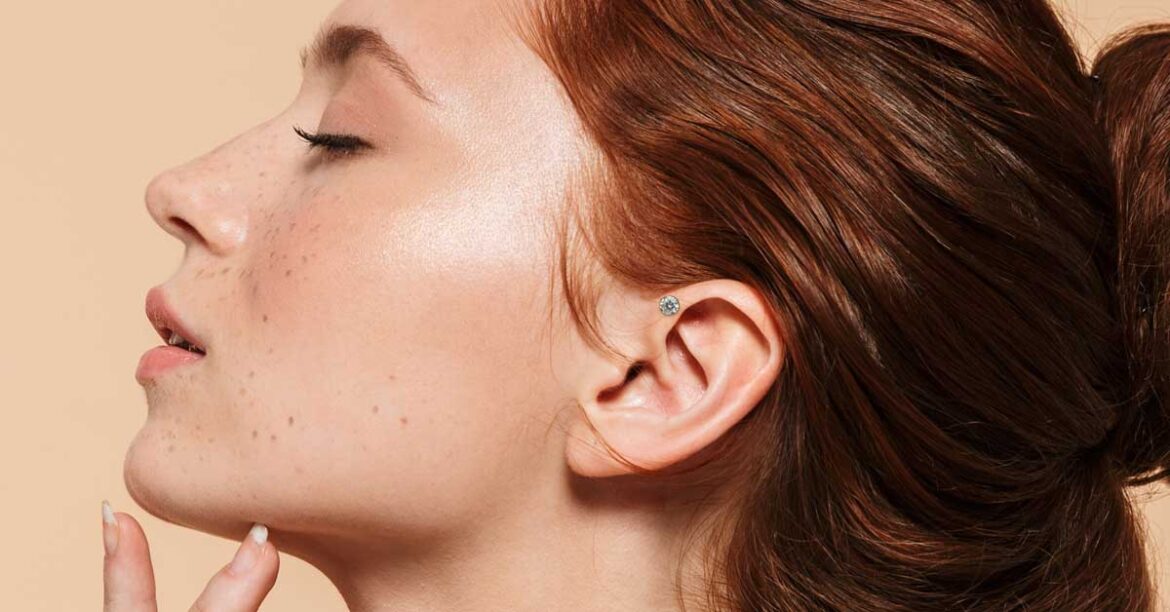What is Forward Helix Piercing?
The forward helix piercing is a type of ear piercing that passes through the outermost cartilage of the ear.
It is typically worn as a single stud or hoop, but can also be adorned with multiple piercings.
This type of piercing is growing in popularity due to its unique and trendy appearance.
There are a few things to consider before getting a forward helix piercing.
First, it is important to make sure that you are not allergic to any of the materials used in body piercings (such as nickel).
Second, it is essential to find a reputable and experienced piercer who can perform the procedure safely and correctly.
Finally, be sure to follow all aftercare instructions carefully to avoid infection or other complications.
For further details you ca visit- Ear Pircing Interactive Chart
Forward Helix Piercing – Procedure
The forward helix piercing is typically done with a needle, although some piercers may use a piercing gun.
First, the area to be pierced will be cleaned and marked.
Next, a needle or piercing gun will be inserted through the ear cartilage.
The jewelry will then be inserted and the piercer will check to make sure that it is secure.
Finally, the piercer will apply pressure to the area and clean any blood or discharge from the wound.
Aftercare
It is important to follow all aftercare instructions given by your piercer in order to avoid infection or other complications.
These instructions may include cleaning the piercing with saltwater several times a day, avoiding touching or playing with
the piercing, and avoiding contact with dirty or contaminated surfaces.
Additionally, it is important to watch for signs of infection, such as excessive redness, swelling, discharge, or pain.
If you experience any of these symptoms, please contact your piercer or healthcare provider immediately.
Possible Complications
As with any piercing or medical procedure, there are some risks associated with the forward helix piercing.
These risks include infection, allergic reaction, swelling, and pain.
However, these risks can be minimized by following all aftercare instructions and choosing a reputable and experienced
piercer.
If you experience any complications after getting your forward helix piercing, please contact your piercer or healthcare
provider immediately.
Jewelry for Forward Helix Piercing
There are many different types of jewelry that can be worn in a forward helix piercing.
The most popular options include studs, hoops, and barbells.
However, there are many other creative and unique options available.
Talk to your piercer about the best type of jewelry for your individual piercing.
If you’re looking for something different than the traditional ear piercing, the forward helix piercing is a great option.
This type of piercing is trendy, unique, and relatively easy to care for.
How Much Does a Forward Helix Piercing Cost?
The cost of a forward helix piercing will vary depending on the piercer, the location, and the type of jewelry used.
However, you can expect to pay anywhere from $30 to $100 for the procedure.
What is the Pain Level of It?
The pain level of a forward helix piercing will vary from person to person.
Some people report feeling only a brief moment of discomfort, while others find the pain to be more moderate.
What is the Healing Time?
The healing time for a forward helix piercing is typically six to eight weeks.
However, it is important to follow all aftercare instructions and contact your piercer or healthcare provider if you experience
any complications.
Can I Do It Myself?
Piercings should only be performed by a professional piercer in a clean and sterilized environment.
Attempting to pierce your own ears can lead to infection, allergic reaction, and other complications.
How Can I Take Care of It?
It is important to follow all aftercare instructions given by your piercer.
These instructions may include cleaning the piercing with saltwater several times a day, avoiding touching or playing with
the piercing, and avoiding contact with dirty or contaminated surfaces.
Additionally, it is important to watch for signs of infection, such as excessive redness, swelling, discharge, or pain.
If you experience any of these symptoms, please contact your piercer or healthcare provider immediately.
What Should I Do if I Experience Complications?
If you experience any complications after getting your forward helix piercing, please contact your piercer or healthcare
provider immediately.
Complications may include infection, allergic reaction, swelling, and pain.
To Sum Up…
The forward helix piercing is a unique and trendy ear piercing that is relatively easy to care for.
The cost of the procedure will vary depending on the piercer, the location, and the type of jewelry used.
The healing time is typically six to eight weeks, but it is important to follow all aftercare instructions and contact your
piercer or healthcare provider if you experience any complications.

